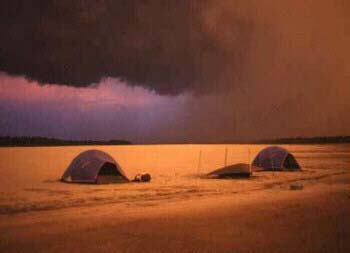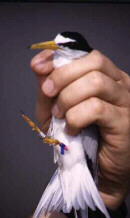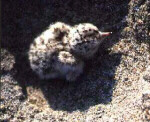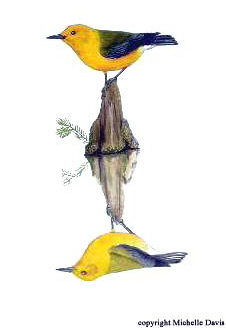| |
SITE DESCRIPTION
 |
We conducted research
at four sites located on sand bars along the Lower Mississippi
River between Memphis, Tennessee and Friars Point, Mississippi:
Kangaroo Point (Phillips Co., Arkansas, River Mile 647),
St. Francis Dikes (Tunica Co., Mississippi, River Mile
672), Porter Lake Dikes (Crittenden Co., Arkansas, River
Mile 700), and Cow Island Bend (DeSoto Co., Mississippi,
River Mile 715). The sandbars/islands were open expanses
of sandy substrate mostly devoid of any vegetative cover
and ranged in size from 0.9 km 2 to 2.7
km 2 during peak nesting.
|
RESEARCH ACTIVITY
We studied the
reproductive ecology of the interior population of Least
Terns (Sterna antillarum athalassos) at four
colonies during the 1995-1997 breeding seasons. We estimated
total number of nests per sandbar, the mean and mode
clutch size, mean length of incubation, the number of
successful and failed nests, and hatching success.
In order to estimate
actual reproductive success, which was defined as the
number of fledglings produced per successful nest, we
employed a capture-recapture method. A crew of 10 to
15 volunteers would spread across the width of a sandbar
and walk its length herding the fledglings (about 12-16
days old) into a funneled drift fence. The drift fence
stood approximately 45cm high and extended 600 feet
(183m) from the apex of a V shaped setup. Upon capture,
each chick was banded, weighed and aged. Fledgling estimates
were then made using the Lincoln-Peterson estimate.
Over the course of the three years 35 people assisted
with the capture-recapture aspect of the study, which
we like to call the Chick Roundup.
|
 |
CHRIS SZELL
 |
Chris studied
these four colonies of the Interior Least Tern (Sterna
antillarum athalassos) found along the Lower Mississippi
River. This colonial nester , which may also be found
along the Pacific, Atlantic, and Gulf coasts, has been
divided into three subspecies. The interior breeding
population , in which my interest lies, was first extensively
studied by John William Hardy (1957). Because of the
recent decline in the population of the interior Least
Tern, attributed to the degradation of its riverine
sandbar habitat (Smith and Renken 1993, USFWS 1985,
USFWS 1990), the species was listed endangered throughout
the central portion of the United States on June 27,
1985 (USFWS 1985). Impoundment, channelization, and
stabilization projects designed to achieve flood control
and navigation objectives have been faulted for population
declines. Because of the endangered status of this
species and in lieu of the actions outlined in the species
recovery plan, Chris focused on acquiring reproductive
estimates that would reflect nest and/or egg destruction
and predation events, while excluding non-breeding adults
which would inflate adult estimates.
|
 |
Nesting colonies varied
from 170 to 599 nests. Annual reproductive success was highest
in 1995 (1.27 fledglings/nest) and lowest in 1996 (0.28 fledglings
per nest). Predation and untimely flooding were the largest
negative impacts upon successful tern reproduction. Chris
suggests that according to estimates of reproductive success
and population trends, the average annual reproductive success
(0.68 fledlings per nest) is inadequate to maintain population
stability along the Lower Mississippi River.
Literature Cited
Hardy, J.
W. 1957. The Least Tern in the Mississippi Valley. Publications
of the Museum, Michigan State University Biological Series
1: 1-60. Smith, J. W., and R. B. Renken. 1993. Reproductive
success of Least Terns in the Mississippi River Valley.
Colonial Waterbirds 16: 39-44.
USFWS. 1985.
Endangered and threatened wildlife and plants: Interior population
of the Least Tern determined to be endangered. Federal Register
50: 21784-21792.
USFWS. 1990.
Recovery Plan for the interior population of the Least Tern
(Sterna antillarum). U.S. Fish and Wildlife Service, Twin
Cities, Minnesota.
90pp.
The
University of Southern Mississippi. Last modified:
24 February, 2007
.
Questions and
Comments?
URL: http://www.usm.edu/mbrg/MissRiver..html
AA/EOE/ADAI
|
